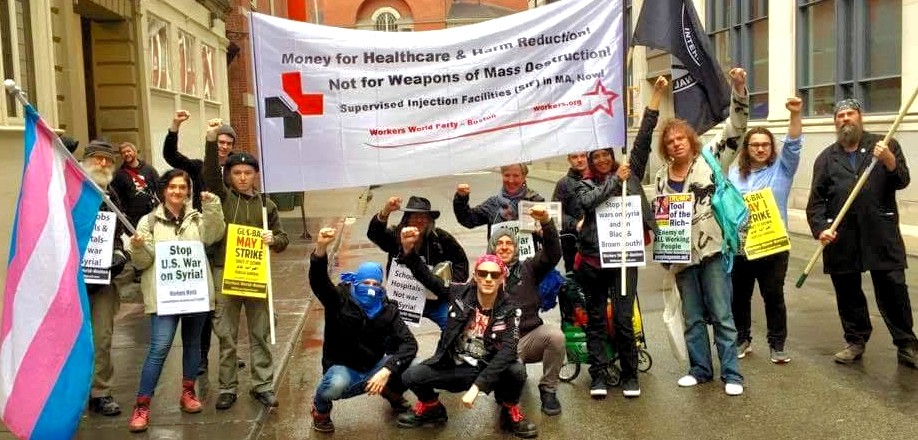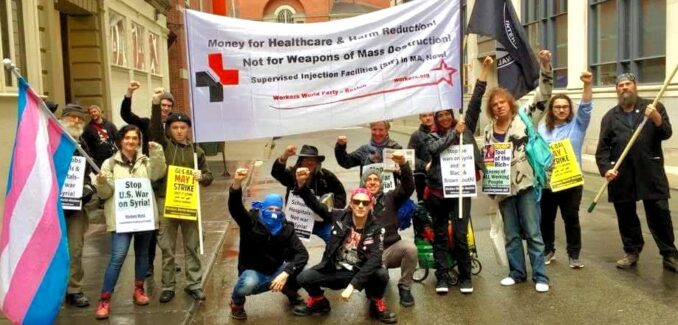

Members of striking United Food and Commercial Workers Local 7 in Denver, Jan. 20. (Photo: Viviana Weinstein)
By AEzra El, Devin Cole and Princess Harmony
Roughly five-and-a-half minutes. Statistically speaking, that’s the interval between every life lost in the United States to a fatal overdose.


Science March, Boston, March 2017.WW Photo: Steve Kirschbaum.
In the past several years, we have seen a radical increase in the rate of overdose deaths in the United States. A particularly potent opioid has contributed to this increase immensely. Fentanyl and its analogs are easily manufactured and do not require a far-away poppy field. They are easily transported and can be domestically produced and, from a supplier’s standpoint, are much more affordable than heroin. Compared to other opioids, they are shorter acting and exceedingly potent. These factors make them ideal for those trafficking in the illicit substance trade.
Their reach isn’t limited to opioids, however. Fentanyls have made their way into cocaine and amphetamine supplies and have been found pressed into clandestinely manufactured pills. People consuming these products have no real way of knowing the potency of the product, and sometimes the nature of the product, prior to consumption; and though harm reductionists, PWUD (people who use drugs) and PWUD advocates have employed test strips that check for the presence of fentanyl, the battle is very much an uphill one. And the death toll is rising. Beyond this, a litany of other admixtures, some poisonous, some psychoactive, have brought with them a compounded risk of potential harm.
So, what is to be done? We know from history that the carceral system and bourgeois law and order will provide no support in this matter. There is no way to beat, jail, put on trial or kill our way out of this. In fact, the legacy of prohibition (and capitalism, more broadly) have unarguably informed the crisis in which we presently find ourselves.
First, we must acknowledge that the use of mind-altering substances is part of the human condition and perhaps even a part of sentience. From social and sacred uses in human history to members of the animal kingdom finding ways to achieve intoxication, drugs are part of our shared experience of consciousness and are here to stay. This should not be a point of distress either; substance consumption whether purely recreational, reverent or responsive can be done safely.
From a practical standpoint, drug use is an extremely common method for coping with day-to-day stressors, be it coffee to prepare oneself for the day ahead, nicotine to pace it out or alcohol to momentarily soften the experience of the pain and neglect inflicted by an existence predicated on wage slavery. These are so common that they are overlooked; but often people dealing with unmet mental health needs, lack of access to pain management and trauma (whatever the source, be it generational or individual) turn to these and other substances to make it through life.
Harm reduction saves lives
For a percentage of people, though statistically a small percentage compared to the total number of consumers, there exists another potentially difficult outcome: problematic relationships. Problematic relationships to substances, often called “addictions,” seem to manifest in situations where an individual’s needs are not being met.
Not exclusive to substances, individuals may develop problematic relationships to various behaviors and/or consumables (such as gambling, gaming, pornography, food). Though many people who experience this phenomenon break free from more chaotic patterns of consumption, either through self-direction or the passage of time, others — often deprived of the very resources necessary to navigate a change of pace — meet with great difficulty.
Society must rally for these individuals. We must recognize that drugs are meeting the needs of PWUDs that society has failed to address. We need an entirely separate approach — one that rejects the misguided individualism that paints these individuals out to be broken or sick and instead acknowledges that this crisis is the product of a profoundly sick and broken society.
We must struggle toward common-sense drug policy, decriminalizing the use of substances and making stigma-free education available. In doing so, we could shift the funds that currently go to beating down these individuals, who are experimenting at least and at most coping, and instead fund social programs and treatment for when things get out of hand. With this pivot alone, we would be doing humanity a great service.
We need to collectively demystify and demand immediate and widespread utilization of harm-reduction strategies.
Supervised consumption spaces provide a necessary safe environment for those who would otherwise consume illicit substances in public bathrooms or alleyways. They provide a point of contact between PWUDs and professionals who care about their safety and can offer them resources if they’d like, but at the bare minimum, can ensure that the hit they take there will not lead to their death.
Needle exchanges should be further funded to prevent the spread of blood-borne pathogens and give PWUDs access to the tools to keep themselves healthy while consuming.
Safe supply as well as expanded access to medication-assisted treatment will allow individuals to choose a regulated, pharmaceutical alternative to illicit substances, while they address the conditions that informed their problematic use.
Greatest threat to life: capitalism
We must make science-backed treatment available for free and on demand. Capitalist profiteering has created a $35 billion per year treatment-industrial complex, out of the same methods one could find in a church basement. A spirituality- and abstinence-based recovery program is not the right answer for every PWUD. Other methods must be made readily available.
Free housing for all must become a priority, along with universal health care and full employment. The commodification of basic human needs must become a thing of the past.
And beyond all these things, we must recognize that where there is poverty, where there is systemic injustice, patriarchal violence, racism, homophobia, transphobia, colonialism and endless war, at the expense of those abroad and at home, there will be trauma; and where there is trauma, problematic relationships to substances and behaviors alike will manifest. If we want change — real, meaningful change — our goals must be no shorter than a complete societal shift, with a caveat of “preserve life by any means necessary” in the immediate.
Opioid overdoses and problematic relationships to substances are a symptom. The epidemic, capitalism, is ultimately the greatest threat to life.
Boston, April 20, 2025 The leadership of the Democratic Party nationally and especially in Massachusetts…
Hamas – Islamic Resistance Movement made the following call, “Gaza cries out to you —…
The centennial of the birth of Malcolm X, also known as El-Hajj Malik El-Shabazz, is…
In a courageous act of solidarity with the Palestinian people, a Moroccan port workers’ union…
Buffalo, New York A large group of demonstrators marched on the Buffalo ICE (U.S. Immigration…
In the 1950s, when Japan and much of Europe was in ruins, the U.S. accounted…